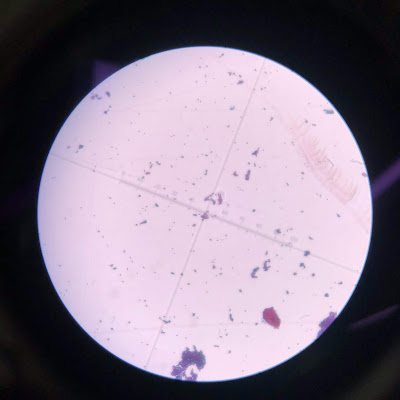Gram Staining Procedure
1. Materials- Crystal violet (primary stain)- Gram's iodine (mordant, to fix crystal violet in the cell wall)- Ethanol or Acetone (decolorizer)- Safranin (secondary stain or counterstain)- DI Water- Microscope slide2. Procedure- Place a small drop of bacterial sample on a slide. Heat fix the bacteria to the slide by passing it through the flame of a Bunsen burner three times. Applying too much heat or for too long can melt the bacteria cell walls, distorting their shape and leading to an inaccurate result. If too little heat is applied, the bacteria will wash off the slide during staining.
- Use a dropper to apply the primary stain (crystal violet) to the slide and allow it to sit for 1 minute. Gently rinse the slide with water no longer than 5 seconds to remove excess stain. Rinsing too long can remove too much color, while not rinsing long enough may allow too much stain to remain on gram-negative cells.
- Use a dropper to apply Gram's iodine to the slide to fix the crystal violet to the cell wall. Let it sit for 1 minute.
- Rinse the slide with alcohol or acetone about 3 seconds, followed immediately with a gentle rinse using water. The gram-negative cells will lose color, while the gram-positive cells will remain violet or blue. However, if the decolorizer is left on too long, all cells will lose color!- - Apply the secondary stain, safranin, and allow it to sit for 1 minute. Gently rinse with water no longer than 5 seconds. The gram-negative cells should be stained red or pink, while the gram-positive cells will still appear purple or blue.
- View the slide using a microscope. A magnification of 4x to 100x may be needed to distinguish cell shape and arrangement.
- Put 1 drop of oil and record the result:
3. Kinds of Gram-Positive (Pink color) and Gram-Negative Pathogens (Purple color)Not all bacteria identified by the Gram stain are associated with diseases, but a few important examples include:- Gram-positive cocci (round) -Staphylococcus aureus
- Gram-negative cocci - Neisseria meningitidis
- Gram-positive bacilli (rods) - Bacillus anthracis
- Gram-negative bacilli - Escherichia coli
4. How the Gram Stain WorksThe Crystal violet (primary stain) binds to peptidoglycan, coloring cells purple. Both gram-positive and gram-negative cells have peptidoglycan in their cell walls, so initially, all bacteria stain violet.Gram's iodine is applied as a mordant or fixative. Gram-positive cells form a crystal violet-iodine complex.Ethanol or Acetone or acetone is used to decolorize the cells. Gram-negative bacteria have much less peptidoglycan in their cell walls, so this step essentially renders them colorless, while only some of the color is removed from gram-positive cells, which have more peptidoglycan (60-90% of the cell wall). The thick cell wall of gram-positive cells is dehydrated by the decolorizing step, causing them to shrink and trapping the stain-iodine complex inside.After the decolorizing step, a counterstain is applied (usually safranin, but sometimes fuchsine) to color the bacteria pink. Both gram-positive and gram-negative bacteria pick up the pink stain, but it is not visible over the darker purple of the gram-positive bacteria. If the staining procedure is performed correctly, gram-positive bacteria will be purple, while gram-negative bacteria will be pink. - Gram-positive cocci (round) -Staphylococcus aureus













Comments
Post a Comment